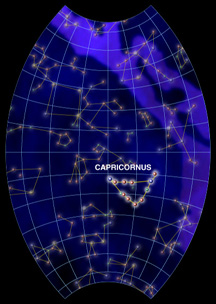Click on image for full size
Windows to the Universe original image
Related links:
Capricornus
The constellation Capricornus represents the figure of either a goat or a sea-goat in the sky. It is believed to be the oldest constellation known. Capricornus is also a member of the Zodiac, a special group of constellations that the Sun travels through every year.
Because Capricornus is so old, there are several different myths about this dim constellation. Some civilizations believed that Capricornus was the Gate of the Gods, a region in the sky where souls passed when humans died. Other beliefs concentrated on a figure of a goat or even a sea-goat. A sea-goat was part goat, part fish.
In Greek myth, Capricornus was associated with Pan. During a picnic, a monster called Typhon attacked the gods. The gods turned themselves into animals and fled, but Pan couldn't decide what to be. Finally, he jumped into the Nile River, at which point he transformed. His lower half was in water, so it became a fish. However, his upper-half was still dry, so it stayed a goat.
The Tropic of Capricorn got its name from this ancient constellation. At one time, the Sun reached the winter solstice while passing in front of Capricornus. At that time, the Sun had reached its lowest point in the southern sky-- 23.5 degrees south of the celestial equator. Even though the winter solstice no longer occurs in Capricorn, we still recognize the Tropic of Capricorn as the lowest latitude on Earth where the Sun lies directly overhead.
Capricornus is one of the dimmest constellations and contains only a few celestial objects. A globular cluster named M30 is located to the left of Capricornus. Lying 41,000 light years from Earth, M30 should be looked at through a telescope to see the individual stars.
It is easiest to see Capricornus in September. You'll find it below Aquarius and next to Aquila.














